PUBH632: Ministerial Briefing Note on National TB Patient Recording
VerifiedAdded on 2022/10/11
|6
|1725
|13
Report
AI Summary
This ministerial briefing note, prepared by a Senior Policy Analyst, addresses the critical issue of national tuberculosis (TB) patient recording. It begins by outlining the challenges of the current state-based system, highlighting the need for a more coordinated approach. The report references the high prevalence of TB in low- and middle-income countries, and the potential for its spread. The note explores policy options, including centrally planned recording, early diagnosis and treatment, and screening measures. The analysis considers the advantages and disadvantages of each option, including cost implications and potential benefits for identifying and treating infected patients, as well as the need for monitoring drug resistance. Ultimately, the report recommends maintaining the status quo of TB patient registration, allowing the ministry to track infected individuals and develop strategies for prevention and control. The recommendation is supported by references to academic literature and government guidelines.
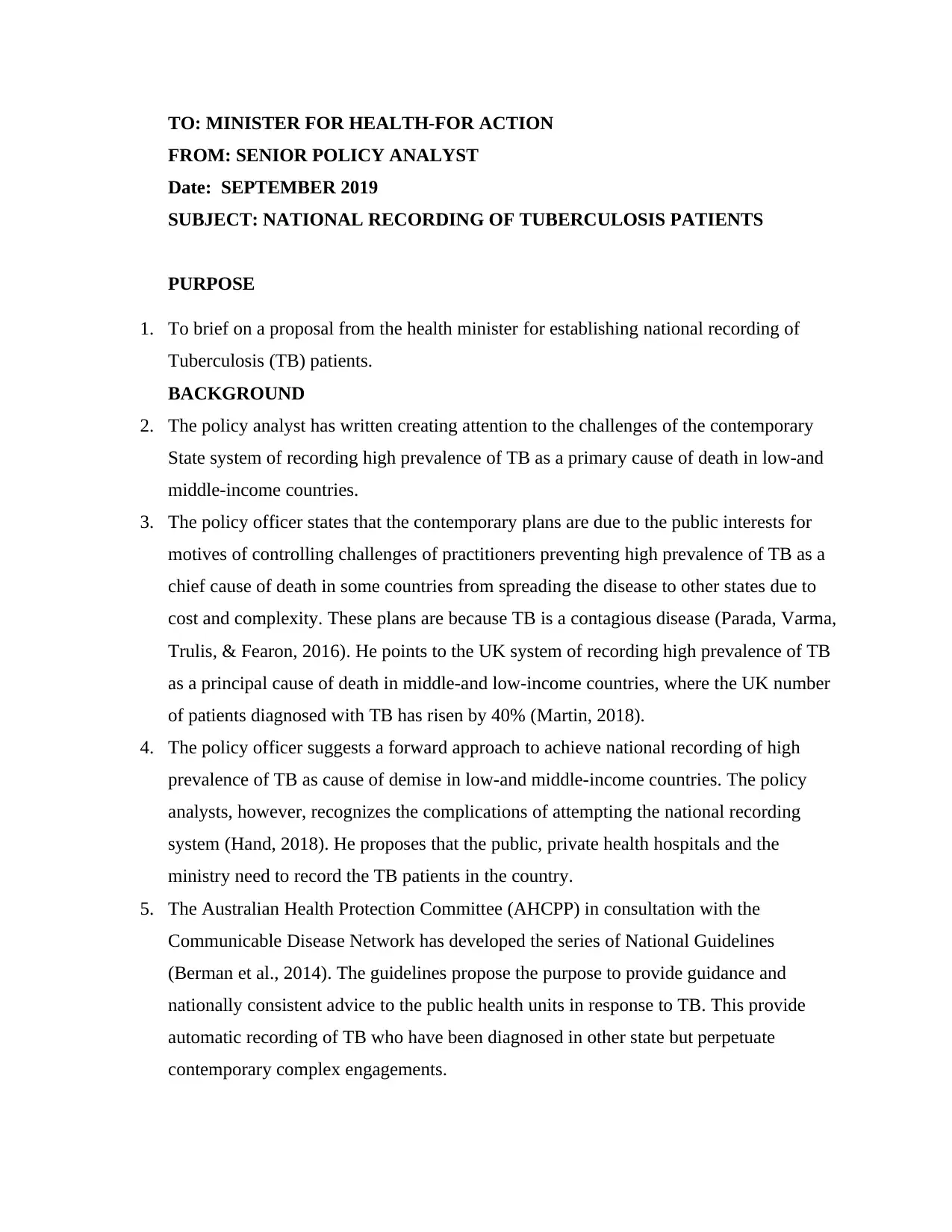
TO: MINISTER FOR HEALTH-FOR ACTION
FROM: SENIOR POLICY ANALYST
Date: SEPTEMBER 2019
SUBJECT: NATIONAL RECORDING OF TUBERCULOSIS PATIENTS
PURPOSE
1. To brief on a proposal from the health minister for establishing national recording of
Tuberculosis (TB) patients.
BACKGROUND
2. The policy analyst has written creating attention to the challenges of the contemporary
State system of recording high prevalence of TB as a primary cause of death in low-and
middle-income countries.
3. The policy officer states that the contemporary plans are due to the public interests for
motives of controlling challenges of practitioners preventing high prevalence of TB as a
chief cause of death in some countries from spreading the disease to other states due to
cost and complexity. These plans are because TB is a contagious disease (Parada, Varma,
Trulis, & Fearon, 2016). He points to the UK system of recording high prevalence of TB
as a principal cause of death in middle-and low-income countries, where the UK number
of patients diagnosed with TB has risen by 40% (Martin, 2018).
4. The policy officer suggests a forward approach to achieve national recording of high
prevalence of TB as cause of demise in low-and middle-income countries. The policy
analysts, however, recognizes the complications of attempting the national recording
system (Hand, 2018). He proposes that the public, private health hospitals and the
ministry need to record the TB patients in the country.
5. The Australian Health Protection Committee (AHCPP) in consultation with the
Communicable Disease Network has developed the series of National Guidelines
(Berman et al., 2014). The guidelines propose the purpose to provide guidance and
nationally consistent advice to the public health units in response to TB. This provide
automatic recording of TB who have been diagnosed in other state but perpetuate
contemporary complex engagements.
FROM: SENIOR POLICY ANALYST
Date: SEPTEMBER 2019
SUBJECT: NATIONAL RECORDING OF TUBERCULOSIS PATIENTS
PURPOSE
1. To brief on a proposal from the health minister for establishing national recording of
Tuberculosis (TB) patients.
BACKGROUND
2. The policy analyst has written creating attention to the challenges of the contemporary
State system of recording high prevalence of TB as a primary cause of death in low-and
middle-income countries.
3. The policy officer states that the contemporary plans are due to the public interests for
motives of controlling challenges of practitioners preventing high prevalence of TB as a
chief cause of death in some countries from spreading the disease to other states due to
cost and complexity. These plans are because TB is a contagious disease (Parada, Varma,
Trulis, & Fearon, 2016). He points to the UK system of recording high prevalence of TB
as a principal cause of death in middle-and low-income countries, where the UK number
of patients diagnosed with TB has risen by 40% (Martin, 2018).
4. The policy officer suggests a forward approach to achieve national recording of high
prevalence of TB as cause of demise in low-and middle-income countries. The policy
analysts, however, recognizes the complications of attempting the national recording
system (Hand, 2018). He proposes that the public, private health hospitals and the
ministry need to record the TB patients in the country.
5. The Australian Health Protection Committee (AHCPP) in consultation with the
Communicable Disease Network has developed the series of National Guidelines
(Berman et al., 2014). The guidelines propose the purpose to provide guidance and
nationally consistent advice to the public health units in response to TB. This provide
automatic recording of TB who have been diagnosed in other state but perpetuate
contemporary complex engagements.
Paraphrase This Document
Need a fresh take? Get an instant paraphrase of this document with our AI Paraphraser
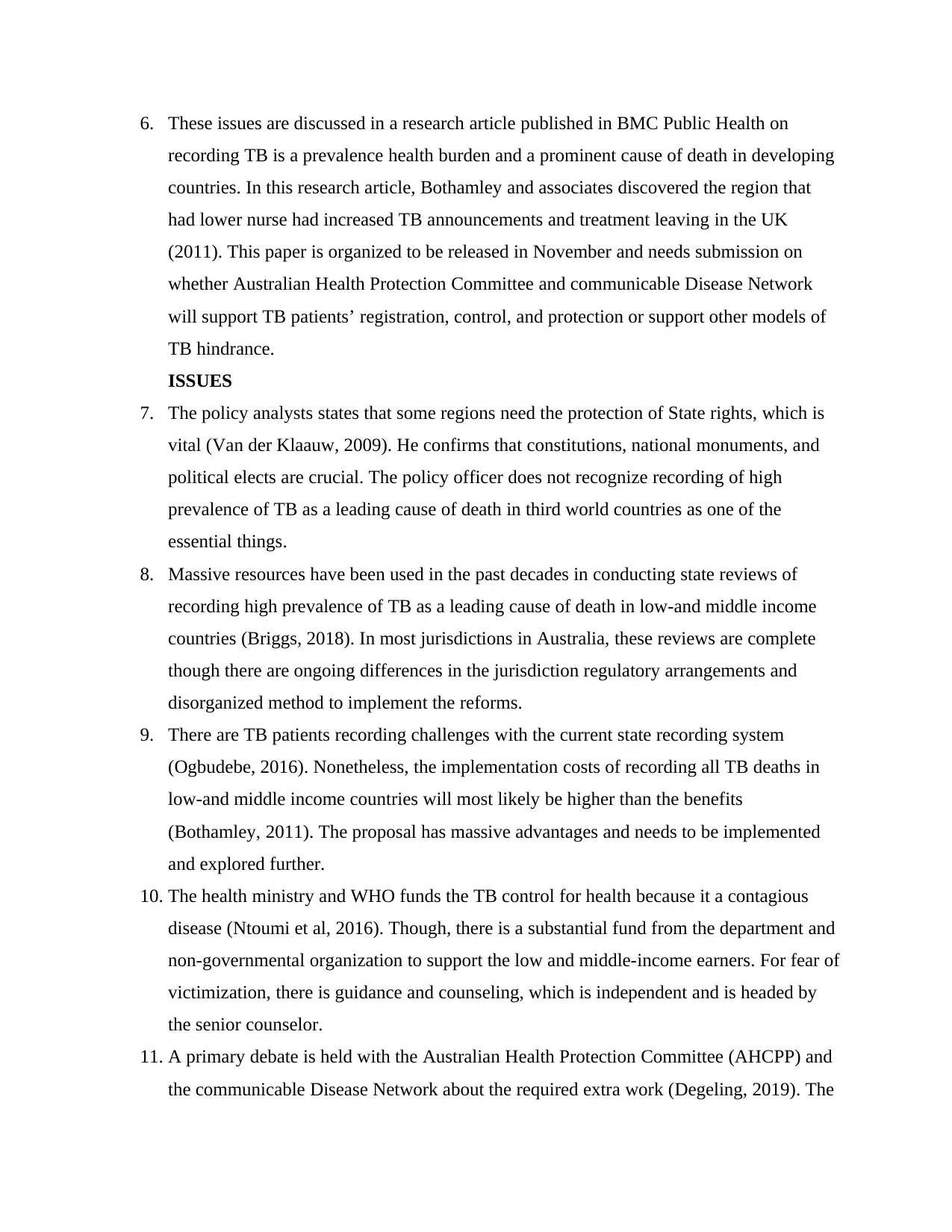
6. These issues are discussed in a research article published in BMC Public Health on
recording TB is a prevalence health burden and a prominent cause of death in developing
countries. In this research article, Bothamley and associates discovered the region that
had lower nurse had increased TB announcements and treatment leaving in the UK
(2011). This paper is organized to be released in November and needs submission on
whether Australian Health Protection Committee and communicable Disease Network
will support TB patients’ registration, control, and protection or support other models of
TB hindrance.
ISSUES
7. The policy analysts states that some regions need the protection of State rights, which is
vital (Van der Klaauw, 2009). He confirms that constitutions, national monuments, and
political elects are crucial. The policy officer does not recognize recording of high
prevalence of TB as a leading cause of death in third world countries as one of the
essential things.
8. Massive resources have been used in the past decades in conducting state reviews of
recording high prevalence of TB as a leading cause of death in low-and middle income
countries (Briggs, 2018). In most jurisdictions in Australia, these reviews are complete
though there are ongoing differences in the jurisdiction regulatory arrangements and
disorganized method to implement the reforms.
9. There are TB patients recording challenges with the current state recording system
(Ogbudebe, 2016). Nonetheless, the implementation costs of recording all TB deaths in
low-and middle income countries will most likely be higher than the benefits
(Bothamley, 2011). The proposal has massive advantages and needs to be implemented
and explored further.
10. The health ministry and WHO funds the TB control for health because it a contagious
disease (Ntoumi et al, 2016). Though, there is a substantial fund from the department and
non-governmental organization to support the low and middle-income earners. For fear of
victimization, there is guidance and counseling, which is independent and is headed by
the senior counselor.
11. A primary debate is held with the Australian Health Protection Committee (AHCPP) and
the communicable Disease Network about the required extra work (Degeling, 2019). The
recording TB is a prevalence health burden and a prominent cause of death in developing
countries. In this research article, Bothamley and associates discovered the region that
had lower nurse had increased TB announcements and treatment leaving in the UK
(2011). This paper is organized to be released in November and needs submission on
whether Australian Health Protection Committee and communicable Disease Network
will support TB patients’ registration, control, and protection or support other models of
TB hindrance.
ISSUES
7. The policy analysts states that some regions need the protection of State rights, which is
vital (Van der Klaauw, 2009). He confirms that constitutions, national monuments, and
political elects are crucial. The policy officer does not recognize recording of high
prevalence of TB as a leading cause of death in third world countries as one of the
essential things.
8. Massive resources have been used in the past decades in conducting state reviews of
recording high prevalence of TB as a leading cause of death in low-and middle income
countries (Briggs, 2018). In most jurisdictions in Australia, these reviews are complete
though there are ongoing differences in the jurisdiction regulatory arrangements and
disorganized method to implement the reforms.
9. There are TB patients recording challenges with the current state recording system
(Ogbudebe, 2016). Nonetheless, the implementation costs of recording all TB deaths in
low-and middle income countries will most likely be higher than the benefits
(Bothamley, 2011). The proposal has massive advantages and needs to be implemented
and explored further.
10. The health ministry and WHO funds the TB control for health because it a contagious
disease (Ntoumi et al, 2016). Though, there is a substantial fund from the department and
non-governmental organization to support the low and middle-income earners. For fear of
victimization, there is guidance and counseling, which is independent and is headed by
the senior counselor.
11. A primary debate is held with the Australian Health Protection Committee (AHCPP) and
the communicable Disease Network about the required extra work (Degeling, 2019). The
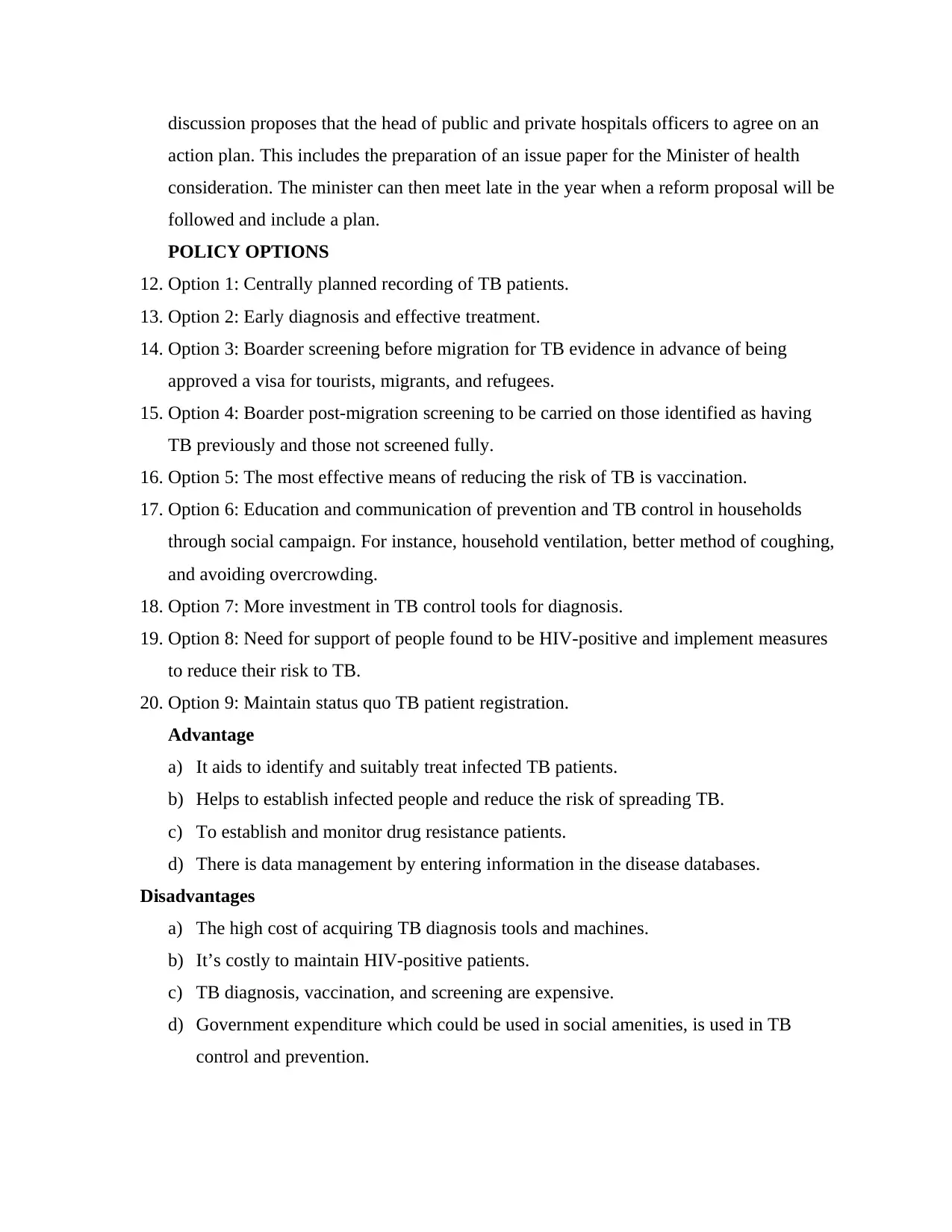
discussion proposes that the head of public and private hospitals officers to agree on an
action plan. This includes the preparation of an issue paper for the Minister of health
consideration. The minister can then meet late in the year when a reform proposal will be
followed and include a plan.
POLICY OPTIONS
12. Option 1: Centrally planned recording of TB patients.
13. Option 2: Early diagnosis and effective treatment.
14. Option 3: Boarder screening before migration for TB evidence in advance of being
approved a visa for tourists, migrants, and refugees.
15. Option 4: Boarder post-migration screening to be carried on those identified as having
TB previously and those not screened fully.
16. Option 5: The most effective means of reducing the risk of TB is vaccination.
17. Option 6: Education and communication of prevention and TB control in households
through social campaign. For instance, household ventilation, better method of coughing,
and avoiding overcrowding.
18. Option 7: More investment in TB control tools for diagnosis.
19. Option 8: Need for support of people found to be HIV-positive and implement measures
to reduce their risk to TB.
20. Option 9: Maintain status quo TB patient registration.
Advantage
a) It aids to identify and suitably treat infected TB patients.
b) Helps to establish infected people and reduce the risk of spreading TB.
c) To establish and monitor drug resistance patients.
d) There is data management by entering information in the disease databases.
Disadvantages
a) The high cost of acquiring TB diagnosis tools and machines.
b) It’s costly to maintain HIV-positive patients.
c) TB diagnosis, vaccination, and screening are expensive.
d) Government expenditure which could be used in social amenities, is used in TB
control and prevention.
action plan. This includes the preparation of an issue paper for the Minister of health
consideration. The minister can then meet late in the year when a reform proposal will be
followed and include a plan.
POLICY OPTIONS
12. Option 1: Centrally planned recording of TB patients.
13. Option 2: Early diagnosis and effective treatment.
14. Option 3: Boarder screening before migration for TB evidence in advance of being
approved a visa for tourists, migrants, and refugees.
15. Option 4: Boarder post-migration screening to be carried on those identified as having
TB previously and those not screened fully.
16. Option 5: The most effective means of reducing the risk of TB is vaccination.
17. Option 6: Education and communication of prevention and TB control in households
through social campaign. For instance, household ventilation, better method of coughing,
and avoiding overcrowding.
18. Option 7: More investment in TB control tools for diagnosis.
19. Option 8: Need for support of people found to be HIV-positive and implement measures
to reduce their risk to TB.
20. Option 9: Maintain status quo TB patient registration.
Advantage
a) It aids to identify and suitably treat infected TB patients.
b) Helps to establish infected people and reduce the risk of spreading TB.
c) To establish and monitor drug resistance patients.
d) There is data management by entering information in the disease databases.
Disadvantages
a) The high cost of acquiring TB diagnosis tools and machines.
b) It’s costly to maintain HIV-positive patients.
c) TB diagnosis, vaccination, and screening are expensive.
d) Government expenditure which could be used in social amenities, is used in TB
control and prevention.
⊘ This is a preview!⊘
Do you want full access?
Subscribe today to unlock all pages.

Trusted by 1+ million students worldwide
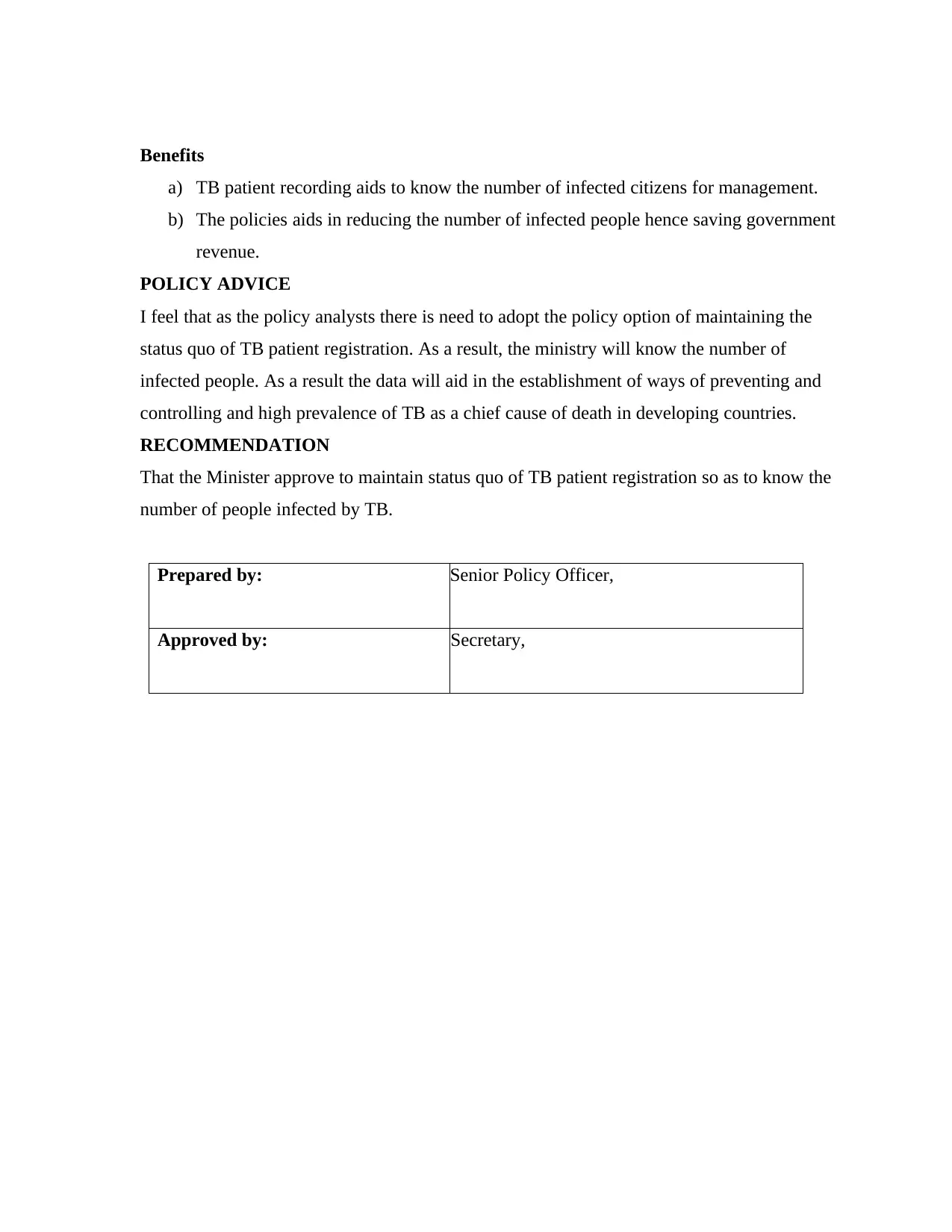
Benefits
a) TB patient recording aids to know the number of infected citizens for management.
b) The policies aids in reducing the number of infected people hence saving government
revenue.
POLICY ADVICE
I feel that as the policy analysts there is need to adopt the policy option of maintaining the
status quo of TB patient registration. As a result, the ministry will know the number of
infected people. As a result the data will aid in the establishment of ways of preventing and
controlling and high prevalence of TB as a chief cause of death in developing countries.
RECOMMENDATION
That the Minister approve to maintain status quo of TB patient registration so as to know the
number of people infected by TB.
Prepared by: Senior Policy Officer,
Approved by: Secretary,
a) TB patient recording aids to know the number of infected citizens for management.
b) The policies aids in reducing the number of infected people hence saving government
revenue.
POLICY ADVICE
I feel that as the policy analysts there is need to adopt the policy option of maintaining the
status quo of TB patient registration. As a result, the ministry will know the number of
infected people. As a result the data will aid in the establishment of ways of preventing and
controlling and high prevalence of TB as a chief cause of death in developing countries.
RECOMMENDATION
That the Minister approve to maintain status quo of TB patient registration so as to know the
number of people infected by TB.
Prepared by: Senior Policy Officer,
Approved by: Secretary,
Paraphrase This Document
Need a fresh take? Get an instant paraphrase of this document with our AI Paraphraser
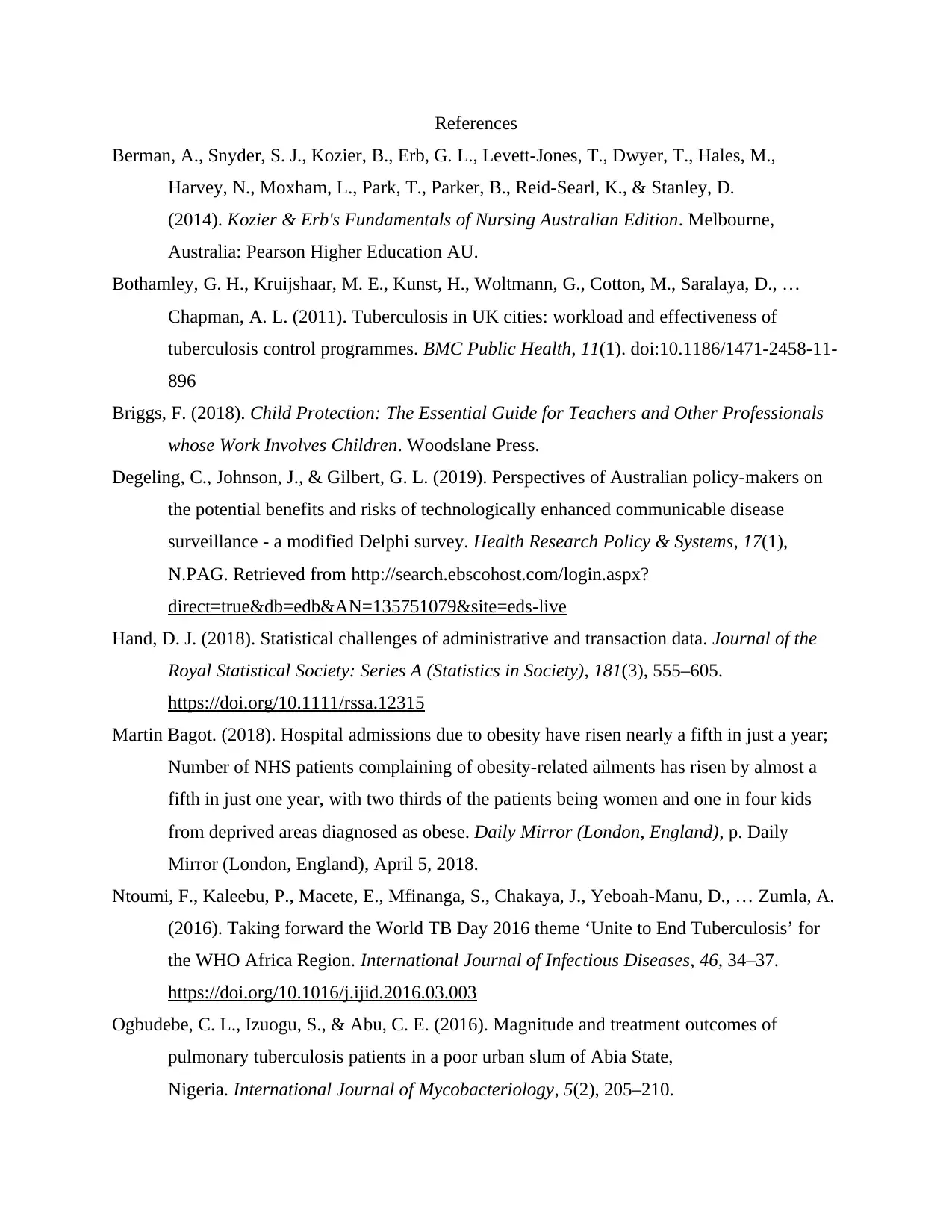
References
Berman, A., Snyder, S. J., Kozier, B., Erb, G. L., Levett-Jones, T., Dwyer, T., Hales, M.,
Harvey, N., Moxham, L., Park, T., Parker, B., Reid-Searl, K., & Stanley, D.
(2014). Kozier & Erb's Fundamentals of Nursing Australian Edition. Melbourne,
Australia: Pearson Higher Education AU.
Bothamley, G. H., Kruijshaar, M. E., Kunst, H., Woltmann, G., Cotton, M., Saralaya, D., …
Chapman, A. L. (2011). Tuberculosis in UK cities: workload and effectiveness of
tuberculosis control programmes. BMC Public Health, 11(1). doi:10.1186/1471-2458-11-
896
Briggs, F. (2018). Child Protection: The Essential Guide for Teachers and Other Professionals
whose Work Involves Children. Woodslane Press.
Degeling, C., Johnson, J., & Gilbert, G. L. (2019). Perspectives of Australian policy-makers on
the potential benefits and risks of technologically enhanced communicable disease
surveillance - a modified Delphi survey. Health Research Policy & Systems, 17(1),
N.PAG. Retrieved from http://search.ebscohost.com/login.aspx?
direct=true&db=edb&AN=135751079&site=eds-live
Hand, D. J. (2018). Statistical challenges of administrative and transaction data. Journal of the
Royal Statistical Society: Series A (Statistics in Society), 181(3), 555–605.
https://doi.org/10.1111/rssa.12315
Martin Bagot. (2018). Hospital admissions due to obesity have risen nearly a fifth in just a year;
Number of NHS patients complaining of obesity-related ailments has risen by almost a
fifth in just one year, with two thirds of the patients being women and one in four kids
from deprived areas diagnosed as obese. Daily Mirror (London, England), p. Daily
Mirror (London, England), April 5, 2018.
Ntoumi, F., Kaleebu, P., Macete, E., Mfinanga, S., Chakaya, J., Yeboah-Manu, D., … Zumla, A.
(2016). Taking forward the World TB Day 2016 theme ‘Unite to End Tuberculosis’ for
the WHO Africa Region. International Journal of Infectious Diseases, 46, 34–37.
https://doi.org/10.1016/j.ijid.2016.03.003
Ogbudebe, C. L., Izuogu, S., & Abu, C. E. (2016). Magnitude and treatment outcomes of
pulmonary tuberculosis patients in a poor urban slum of Abia State,
Nigeria. International Journal of Mycobacteriology, 5(2), 205–210.
Berman, A., Snyder, S. J., Kozier, B., Erb, G. L., Levett-Jones, T., Dwyer, T., Hales, M.,
Harvey, N., Moxham, L., Park, T., Parker, B., Reid-Searl, K., & Stanley, D.
(2014). Kozier & Erb's Fundamentals of Nursing Australian Edition. Melbourne,
Australia: Pearson Higher Education AU.
Bothamley, G. H., Kruijshaar, M. E., Kunst, H., Woltmann, G., Cotton, M., Saralaya, D., …
Chapman, A. L. (2011). Tuberculosis in UK cities: workload and effectiveness of
tuberculosis control programmes. BMC Public Health, 11(1). doi:10.1186/1471-2458-11-
896
Briggs, F. (2018). Child Protection: The Essential Guide for Teachers and Other Professionals
whose Work Involves Children. Woodslane Press.
Degeling, C., Johnson, J., & Gilbert, G. L. (2019). Perspectives of Australian policy-makers on
the potential benefits and risks of technologically enhanced communicable disease
surveillance - a modified Delphi survey. Health Research Policy & Systems, 17(1),
N.PAG. Retrieved from http://search.ebscohost.com/login.aspx?
direct=true&db=edb&AN=135751079&site=eds-live
Hand, D. J. (2018). Statistical challenges of administrative and transaction data. Journal of the
Royal Statistical Society: Series A (Statistics in Society), 181(3), 555–605.
https://doi.org/10.1111/rssa.12315
Martin Bagot. (2018). Hospital admissions due to obesity have risen nearly a fifth in just a year;
Number of NHS patients complaining of obesity-related ailments has risen by almost a
fifth in just one year, with two thirds of the patients being women and one in four kids
from deprived areas diagnosed as obese. Daily Mirror (London, England), p. Daily
Mirror (London, England), April 5, 2018.
Ntoumi, F., Kaleebu, P., Macete, E., Mfinanga, S., Chakaya, J., Yeboah-Manu, D., … Zumla, A.
(2016). Taking forward the World TB Day 2016 theme ‘Unite to End Tuberculosis’ for
the WHO Africa Region. International Journal of Infectious Diseases, 46, 34–37.
https://doi.org/10.1016/j.ijid.2016.03.003
Ogbudebe, C. L., Izuogu, S., & Abu, C. E. (2016). Magnitude and treatment outcomes of
pulmonary tuberculosis patients in a poor urban slum of Abia State,
Nigeria. International Journal of Mycobacteriology, 5(2), 205–210.
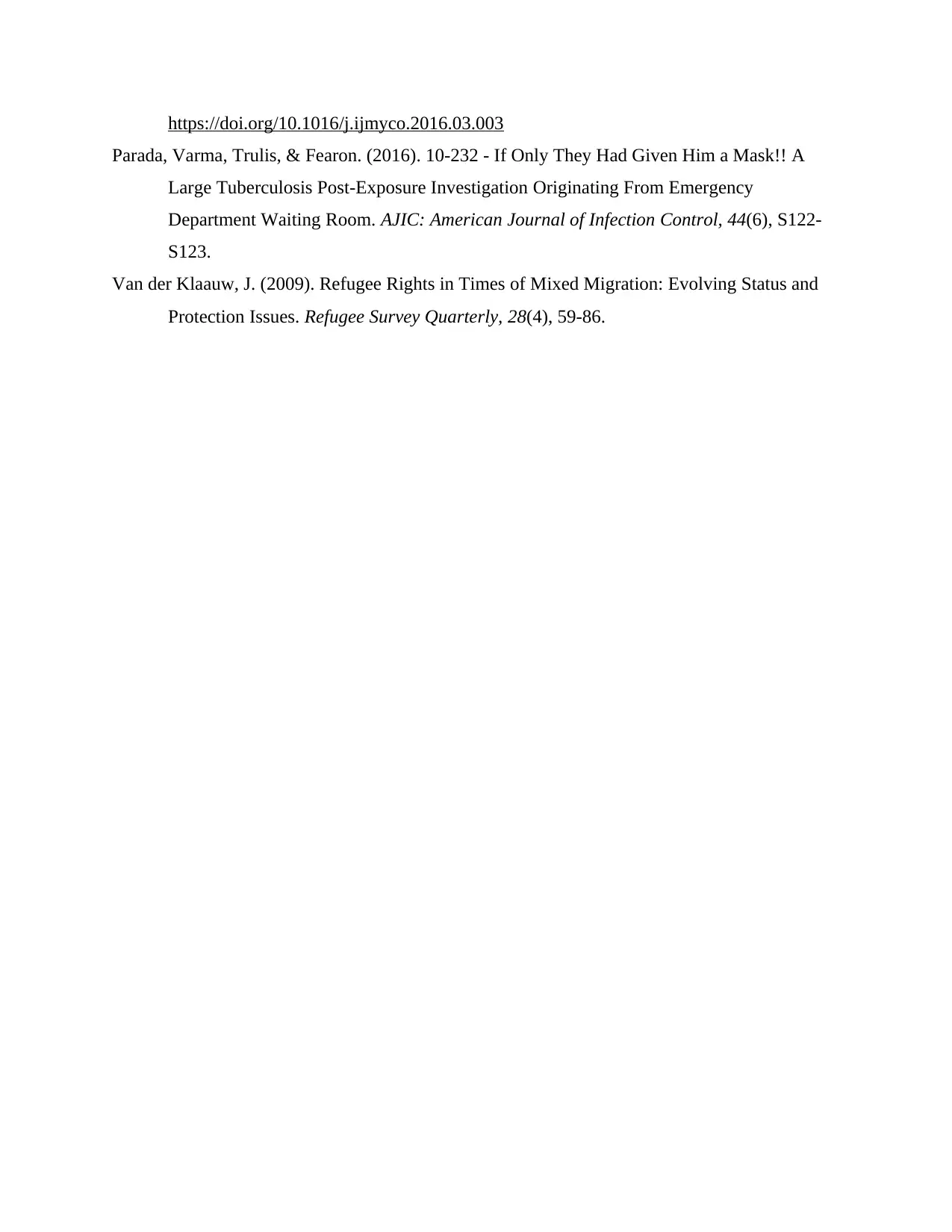
https://doi.org/10.1016/j.ijmyco.2016.03.003
Parada, Varma, Trulis, & Fearon. (2016). 10-232 - If Only They Had Given Him a Mask!! A
Large Tuberculosis Post-Exposure Investigation Originating From Emergency
Department Waiting Room. AJIC: American Journal of Infection Control, 44(6), S122-
S123.
Van der Klaauw, J. (2009). Refugee Rights in Times of Mixed Migration: Evolving Status and
Protection Issues. Refugee Survey Quarterly, 28(4), 59-86.
Parada, Varma, Trulis, & Fearon. (2016). 10-232 - If Only They Had Given Him a Mask!! A
Large Tuberculosis Post-Exposure Investigation Originating From Emergency
Department Waiting Room. AJIC: American Journal of Infection Control, 44(6), S122-
S123.
Van der Klaauw, J. (2009). Refugee Rights in Times of Mixed Migration: Evolving Status and
Protection Issues. Refugee Survey Quarterly, 28(4), 59-86.
⊘ This is a preview!⊘
Do you want full access?
Subscribe today to unlock all pages.

Trusted by 1+ million students worldwide
1 out of 6
Related Documents
Your All-in-One AI-Powered Toolkit for Academic Success.
+13062052269
info@desklib.com
Available 24*7 on WhatsApp / Email
![[object Object]](/_next/static/media/star-bottom.7253800d.svg)
Unlock your academic potential
Copyright © 2020–2025 A2Z Services. All Rights Reserved. Developed and managed by ZUCOL.





